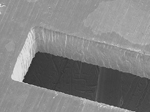13 April 2012
Standing the Heat: Laser Processing Alumina Ceramic
 Alumina ceramic (Al2O3) is used to manufacture many items, including medical prostheses, ballistic armour, laser tubes and circuit boards. Its popularity is due to its strength, durability, corrosion resistance, thermal stability and excellent dielectric properties.
Alumina ceramic (Al2O3) is used to manufacture many items, including medical prostheses, ballistic armour, laser tubes and circuit boards. Its popularity is due to its strength, durability, corrosion resistance, thermal stability and excellent dielectric properties.
However, these characteristics make Al2O3 difficult to process. The material is prone to cracking from thermal stress and traditional techniques such as diamond-grinding can be costly and time consuming.
Rapid technological advances mean it is now possible to use Nd:YAG and fiber lasers to achieve a high standard of finish. These lasers are able to provide the necessary levels of control using variable parameters such as spot size, peak power, pulse duration and frequency.
Optimised laser and processing parameters help minimise heat input, significantly reducing the risk of thermal stress which can lead to cracking. Large scattering of the laser beam, which can be seen at some common wavelengths, can be overcome through a combination of high peak power, short pulses and short wavelengths (1µm).
JK Lasers’ single mode 200W fiber laser (JK200FL) with built-in modulation can achieve good quality cuts in Al2O3 up to 1mm thick (images 1 and 2). It is possible to achieve pulse widths as short as 5µs by gating at a high frequency (50 kHz) which, depending on the purity of the alumina, can provide dramatic improvements to process quality.
Images 3 and 4 show examples of edges that have been cut with a lamp-pumped pulsed Nd:YAG laser (JK100P). The combination of high peak power (10kW), short pulses (15-200µs) and high repetition rate (2000Hz) make this laser well suited to cutting Al2O3 up to 2mm thick. It is possible to cut up to 3mm with multi-passing.
The results demonstrate that both JK Lasers’ SM fiber lasers and lamp-pumped pulsed Nd:YAG lasers can machine Al2O3 between 96 and 99.7% purity. With no evidence of micro-cracking or dross along the cut edge, JK Lasers’ range of fiber and Nd:YAG lasers offer manufacturers a viable alternative to traditional processing techniques.
- Contact Information
- Name: Mark Greenwood
- Email: sales@gsig.com
- Website: www.jklasers.com

